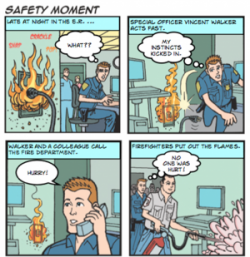Join Ann Wylie for her in-person training session, “Web Writing Boot Camp,” on Sept. 21, 2012 9 a.m.–4 p.m. EDT in New York, N.Y., and learn how to make your posts personable, and write dramatic, compelling status updates that draw followers and get clicks.
![]()
Are you still relying on words alone to tell your stories?
When Campus Progress published an illustrated story on education finance in April 2011, Erin Polgreen reported the following:
- The Huffington Post featured the story on its front page.
- More than 4,000 Facebook users shared and Liked the story.
- The story generated more than 700 tweets.
- More than 800 people commented on the piece.
Polgreen is the founder of Symbolia, a journal that tracks trends in illustrated journalism. The article remains one of the most popular stories of all time for Campus Progress, a national organization that works with and for young people to promote solutions to political and social challenges.
Illustrated journalism — aka graphic storytelling — has seen a spike in interest during recent years, from long-form graphic nonfiction books like Art Spiegelman’s Pulitzer Prize-winning “Maus” and Marjane Satrapi’s “Persepolis.” Now The Dallas Morning News, The Seattle Times, Campus Progress and other news outlets are telling traditional stories through comic strips, cartoons and other forms of graphic storytelling.
Graphic stories are an innovative way for PR pros to spread their message, too. You may use comic strips, comic stories and graphic novels to help do some of the following:
- Generate coverage. Graphic stories are more likely to garner coverage than just plain text. That’s because images dictate coverage for 41 percent of journalists, according to a 2006 study by Bennett & Company. (And they’re rated as important to 90 percent of journalists. As you work to include more visuals in your releases, pitches and posts, graphic stories make a refreshing alternative to boring talking-head videos.
- Spread your message. Readers are more likely to share multimedia than text-only pieces, according to 2011 research conducted by PR Newswire. For instance, two days after the blog The Rumpus published a graphic story about the San Francisco Public Library in May 2011, the piece brought 18,000 visitors to the site, and generated 500 tweets and 2,500 Facebook Likes.
- Get read — and re-read. Three people read the average comic book seven times, according to Custom Comic Services. “Comics are for re-reading, not reading,” Spiegelman says. “They’re harder not to read.”
- Move people to act. People are more likely to act on information that they learn from comics than from text alone, studies show. For instance, more than three-quarters of patients who received cartoon instructions were compliant with daily wound care, according to a 1995 study at the East Carolina University School of Medicine in Greenville, N.C. Only half of those who’d received text-only instructions followed their doctor’s orders. That’s an increase of 50 percent.
- Increase understanding. According to a series of 1996 studies at the University of California, Santa Barbara, students learned 51 percent more from cartoons with captions showing how lightning forms than from 600-word passages describing the process. In most cases, the cartoons were more effective than the same cartoons with the 600-word passages. In fact, the more words that the researchers added to the cartoons, the less the students learned.
Polgreen says that illustrated journalism is fresh, engaging and works with many genres. How could you use comic strips, cartoons and other graphic storytelling approaches to inspire people to read, understand and remember your messages?
Copyright © 2012 Ann Wylie. All rights reserved.
This article originally appeared in the July 2012 issue of Public Relations Tactics.
Ann Wylie, president of Wylie Communications, serves as a PRSA writing trainer and presents writing workshops throughout the country. She is the author of more than a dozen learning tools, including “Writing for Social Media: How to Write Blog Postings, Tweets and Other Status Updates” and “Writing That Sells.”








This sounds like a great idea to get more people to read and understand a message. Seeing words in action will give them more meaning and (hopefully) will stay with the reader for a longer period of time as compared to just reading a message. I think this would be great to use for complicated stories or issues. I know for many people it is often confusing to read about important issues such as the global economy, or in the case in this story education finance. The reason people read the news is to understand what is going on in the world. If the story is too confusing or talks about issues that are over the average citizen’s head, then what is the point?